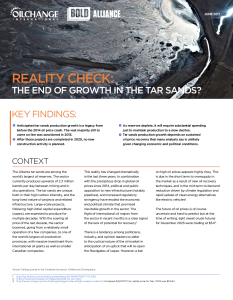Oil Change International
June 2017
The Alberta tar sands are among the world’s largest oil reserves. While investment and expected growth in the industry have been high for the last decade, new industry data paints a dramatically different picture of the sector moving forward. 
Key findings:
- Anticipated tar sands production growth is a legacy from before the 2014 oil price crash. The vast majority still to come on line was sanctioned in 2013.
- After those projects are completed in 2020, no new construction activity is planned.
- As reserves deplete, it will require substantial spending just to maintain production to a slow decline.
- Tar sands production growth depends on sustained oil price recovery that many analysts say is unlikely given changing economic and political conditions.
These have significant implications for ongoing pipeline, climate, and financial planning discussions both at government and industry levels.
For more details on pipeline capacity in the tar sands, see Lockdown: The end of growth in the tar sands. More more on the role of tar sands infrastructure for Canada’s climate commitments, see Climate on the Line: why new tar sands pipelines are incompatible with the Paris climate goals.
